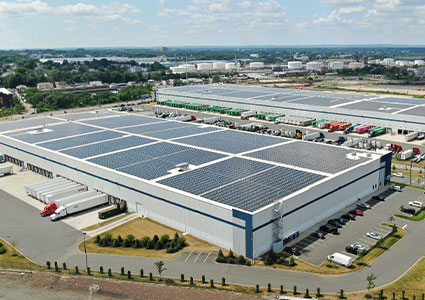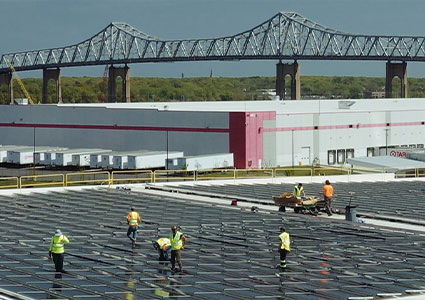“The future pipeline is enormous”: Solar Landscape President Mark Schottinger explains how commercial rooftop solar alleviates America’s unprecedented energy demands
Solar Landscape is on a mission to make solar America’s most shovel-ready energy source, and it aims to do so by building projects on commercial and industrial rooftops.
The growth in AI machine learning, data centers, and the electrification of the economy will drive U.S. energy demands to more than double in the next ten years. Our electric grid infrastructure is not prepared for the required transformation.
That’s why corporations and regulators are increasingly looking to distributed generation (DG) for its deployment speed and grid benefits. DG solar projects can typically be developed and built in 12 to 24 months given faster interconnection times and modular setups.
Once built, these sustainable clean energy projects enable electrical grids to be more resilient, alleviate rate increases and maintain reliable power supplies.
 For commercial real estate owners, building DG solar projects on their rooftops means new net operating income through lease payments. For ratepayers nationwide, it means avoiding energy cost increases due to spiking demand driven by data centers and artificial intelligence.
For commercial real estate owners, building DG solar projects on their rooftops means new net operating income through lease payments. For ratepayers nationwide, it means avoiding energy cost increases due to spiking demand driven by data centers and artificial intelligence.
As the leading commercial rooftop solar developer in the U.S., Solar Landscape partners with the world’s largest real estate firms to develop, install, and operate solar projects on commercial and industrial rooftops. By pioneering this “distributed grid” energy model, the company empowers commercial real estate firms to play an active role in addressing projected increases in energy demands.
Future pipeline
Mark Schottinger, President and Chief Legal Officer, tells us more about Solar Landscape’s evolution and leadership in the market.
“After its founding in 2012, Solar Landscape evolved into a full-scope engineering procurement and construction (EPC) business within seven years, specializing in large commercial and industrial rooftop projects. About six years ago, we expanded the company from a large EPC business to also being a developer, financier, and owner of front-of-meter solar projects, spurred by the state of New Jersey launching a program to encourage such projects. Front-of-meter installations, particularly on rooftops, offer a more scalable solar solution than traditional behind-the-meter projects. In this new market, Solar Landscape proved very successful; we captured a third of the available capacity in the state and continued to invest and expand in that space. We also moved into other markets, including Maryland, Illinois, Minnesota, Pennsylvania, New York, and Massachusetts, and have now leased over 150 million square feet of rooftop for solar. In 2024, we secured $847 million in project financing, supporting roughly 200 projects, demonstrating the confidence in this model,” said Schottinger. “The future pipeline is enormous as commercial and industrial real estate owners are eager to lease their rooftops for solar, presenting untapped opportunities to generate electricity for the grid,” he added.
Extended benefits
Solar Landscape’s approach has revolutionized the pairing of commercial rooftops and America’s energy grid by establishing a novel network of distributed generation sources.
“Behind-the-meter projects require working with building owners through power purchase agreements (PPAs), which involve the building tenant purchasing electricity from the solar system. However, managing PPAs can be complex, and we found that real estate owners prefer to focus on leasing space rather than managing energy matters,” Schottinger explained. “The size of a behind-the-meter project is also limited by the electricity needs of each building. For example, a dry storage warehouse may only need to cover about 20 percent of its roof in solar to meet its energy needs. For these reasons, behind-the-meter roof solar was not very scalable.”
With front-of-meter solar projects, project size is no longer limited by the building’s electricity needs. Instead, the entire roof can be covered with solar panels, generating maximum revenue for the building owner. Instead of managing a complex PPA, the building owner simply leases the roof, and the energy generated by the panels is directed straight into the grid.
In addition to generating revenue for real estate owners, Solar Landscape’s front-of-meter solar projects also benefit the surrounding community. 
“When New Jersey introduced a front-of-meter solar program for rooftops, it revolutionized the market in terms of scalability. The program, known as community solar, involves distributing electricity into the grid and crediting it to residential consumers in the community. As a result, the residential customers save money on their utility bills.”
Vast opportunities
Solar Landscape champions significant community engagement and workforce development programs within its business as part of the community solar program.
“There is an energy crisis happening with an unprecedented surge in electricity demand. We must quickly add a massive amount of energy generation to prevent an extreme shortage of electricity, leading to brownouts and unprecedented price increases. From a policy perspective, we ought to embark on every energy generation project possible. Today more than 90 percent of commercial rooftops don’t have solar, presenting vast opportunities to generate energy,” said Schottinger.
“When we install solar panels close to where electricity is consumed, the electrons travel over a shorter distance through a shorter wire than the distribution and transmission lines utilized by other forms of generation. By installing solar on warehouse and industrial rooftops, we can help avoid costly transmission upgrades. Studies by the Brattle Group have quantified this substantial cost benefit, which is as high as six to nine cents per kWh in some states. According to a 2023 report from Environment America, the rooftops of American warehouses built before 2019 have the potential to generate 185.6 terawatt-hours (TWh) of solar electricity each year, enough to power almost 19.4 million average homes. In order to meet the country’s impending energy needs, we need to build as much energy generation as quickly and efficiently as possible, and rooftop solar projects are the most shovel-ready solution. We can build these projects fast, and are on track to energize multiple gigawatts of high-value generation within five years, which will help mitigate extreme surges in energy demand and cost,” Schottinger concluded.
Through its innovative front-of-meter rooftop solar projects, Solar Landscape is empowering real estate owners to unlock the value of their underutilized rooftops and expand access to affordable clean power for surrounding communities.
Solar Landscape is doing more than leading a new sector in the energy transition; it is creating one.
